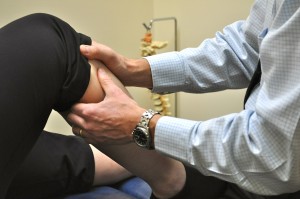 We provide some of the most advanced, comprehensive foot, ankle, knee and hip care available today.
We provide some of the most advanced, comprehensive foot, ankle, knee and hip care available today.
We help many people with lower extremity conditions, including hip pain and bursitis, IT band syndrome, knee pain, knee arthritis, ankle sprains, ankle pain, shin splints, heel pain (plantar fasciitis), arch pain, Achilles tendinitis, forefoot (ball of foot) pain, neuromas, bunions, hammer toes, and numbness.
We treat sports injuries of all types. We have extensive knowledge and experience in running biomechanics and the treatment of running related injuries.
Your lower extremity problem will be addressed differently in our clinic. We will NOT cover up your pain with anti-inflammatory drugs or cortisone injections because these approaches not fix the problem. In the majority of cases, there is an underlying biomechanical “weakness” that is causing the pain.
These are the biomechanical “weaknesses” we look for when evaluating your condition:
• Loss of flexibility of the foot, ankle, knee and hip
• Joint misalignments of the foot, ankle, knee, hip or pelvis
• Poor upper body posture
• Leg deficiency (one leg shorter than the other)
• Poor muscle coordination and muscle weakness of the core (abdominals), hip, leg or foot
Your evaluation will consist of:
• Posture analysis
• Gait (walking) analysis
• Running analysis (if applicable)
• Movement analysis
• Flexibility assessment
• Balance assessment
• Strength assessment
• X-rays (if necessary)
• Shoe inspection
• Orthotic inspection (if applicable)
Once the underlying cause of your condition is determined, a treatment program will be tailored to your specific “weakness” so you can recover as quickly as possible.

Your treatment will consist of one or more of the following:
• Adjustments to the foot, ankle, knee, hips, or spine to restore your joint flexibility and alignment
• Muscle activation to restore your muscle strength
• Exercises to improve your posture, joint alignment and flexibility
• Exercises to improve muscle coordination, balance, and strength of your lower extremities
• Gait retraining
• Heel or shoe lift if you have a short leg and orthotics (arch supports) if necessary
Shoes and Foot Problems
Many patients are surprised when we tell them that their shoes may be contributing to their foot, ankle, knee or hip problem. Shoes can directly impact your walking and running movements depending on the materials and features that are built into the shoe. They can either help your movement or harm your movement. If your shoe is not compatible with your unique way of movement, pain can develop in your foot, knee, hip or lower back. Compound this with a shoe that is worn out, poorly constructed or defective, pain or other problems will be waiting to happen.
Every person’s structure and movements are unique. There are several critical things that need to be determined before choosing the right shoe, including your foot type, foot shape, flexibility, whether you “toe in,” “toe out,” “knock-kneed” or “bowlegged.” Once your unique movements are determined, we will know the type of shoe that will be best for you.
We understand the important role of footwear in the resolution and prevention of lower extremity problems. As a part of your treatment program, we will inspect your footwear and help guide you into the appropriate footwear for your foot type.
